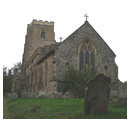  |
 |
 |
 |
 |
| Wed 14 Jan 2026 |

The History Of All Saints' StansfieldHistoryOf the Church which existed in Stansfield at the time of the Norman conquest and is referred to in the Domesday book, we have no sure knowledge, although the Revd J.R. Little, Rector of Stansfield 1890 - 1913 , in his parish notes wrote:- "Of that Church nothing is now standing, but a few fragments of "Norman" masonry and several pieces of Roman concrete may be seen embedded in the walls of the present fabric and hard by lies a small square cap of a respond or corbel of the transitional period, circa 1190 with graceful foliation." In the Churchyard close by the Priest's door lies the remains of a wedge shaped stone coffin like structure, which might be Saxon. The present Church consists of the Chancel, Nave, South porch, - a doorway on the North side has been partly blocked with bricks- and the splendid Western tower which is over seventy feet high. The tower is C14 , it was restored in 1896 and has recently been well restored again by the efforts of the Stansfield Church Restoration Committee and the whole village. Messrs Valiants of Barrow carrying out the actual work. The restoration of 1886 and 1896The local paper reported on November 18, 1896 "Stansfield. Opening of the New Ring of Bells" "About ten years ago the nave and chancel of All Saints' Church, Stansfield were thoroughly repaired by the late rector and the parishioners at an expense of over £1400, but owing to lack of funds the projected repair of the tower and bells was not then carried out. Since the advent of the present rector, the Revd J.R. Little, in 1890, the matter has been kept prominently before the parishioners, and about August last year the subject took practical shape, and a fund was gradually raised which seemed to justify the committee in commencing the work, and this was accordingly done in June last." Stansfield Parochial RegistersThe chief interest in these registers lies in the fact of their being complete from Henry VIII time, with one exception mentioned below. In 1538 Thomas Cromwell issued instructions to the clergy ordering them to write therein every person's name that should be wedded, christened or buried, with the day and year. This order was complied within Stansfield. In 1597 it was ordered by the Syunod that a parchment volume should be provided at the cost of the parish, and that into it should be transcribed all the contents of the old books. This, too, was done so far as concerned names and dates. The first book is a thin parchment folio, entitled "Liber Registrarius de Stansfelde in Com. Suff" The first page is headed "Catalogus nominum eorum qui in parochial dicta de Stansfelde baptiz." It begins "Anno 30 R. H." From 1538 -1599 the entries are all written in court hand. The first few contain only the name of the child's father, thus: "ffl. W. Andrew baptiz." Three years later the child's name is also given, thus: "Robt. Lot fil. Robt. Lot baptiz."From 1554 - 1563, only the child's name, as, "Alicia Orbell baptiz." From 1563 - 84 the entries give the names of both parents. From 1585 - 99 "Tempore M. Nicolai Waldronde Rectoris Eccl. Stansfelde," - thus, "Johannes Sparrow fil. Joh. Et Annae ux. Baptiz" The end of the copy is signed by N. Walronde and the churchwardens, John Sparrow and Robert Hammond. Thus the registers had gradually become more exact. The entries then continue in an inferior court hand for another year. Then "Rectore de Stansf. Jac. Rowe," they are in current hand. Many of the names in the 16th century register are still represented in the parish or were until recently. No marriages were registered between 1642 and 1661, how can this gap of 19 years be accounted for? It would seem that under the act of 1653 marriage became a civil ceremony, and the functions of the Clergy were transferred to the Justices of the Peace; and the registers of such marriages may have been kept elsewhere. But how about the years 1643 - 53? In 1653 Parliament ordered every parish to elect a lay registrar. Accordingly we find before the registers of births and deaths of that time, "The first yeare of ffrancis Younge, elected and sworn according to Act of Parliament, beginning the ffeast of St Michael tharchengel, 1653". From 1653 - 61 the entries of births, baptisms, and burials are in English and well kept, containing the dates both of birth and baptism. It is worth noticing with what care baptism was attended to, and how soon after birth it was administered; surely this must have been in private houses? Take one example out of many similar ones: "1655, Anna, the daughter of Thomas Brooke was born the 20th day of ffebruary, and baptized the 22 nd day of the same". The last entry under the Commonwealth is on May 3rd, 1660 and in English. The next is on Aug. 14th of the same year and in Latin, in which language they continued until 1732, when finally Latin was dropped. There are few entries of personal interest. No families above the rank of small gentry appear to have lived in the parish in the last 500 years. The principal families were Frier, Poley, Westroppe, Sparrowe, Kedington or Kerrington, Plume, Golding and Bigg. Among the more uncommon Christian names we find Persenel, Mirabel, and Hamlet (16th and 17th century). On one page are recorded the burials of three centenarians, all women. 1609, 17th Oct "Sepultaest Katherina Deddenham, faemina centum annorum atque eo plus" 1617 "Millesent Ilger uxor Danielis Ilger, sepulta, 19 Martii, faemina centum annorum atque eo plus" 1619. "Elizabetha Jaggard vidua, quae centesimum secundum aetatis annum comleverat, sepulta est 23 die februarii" |

